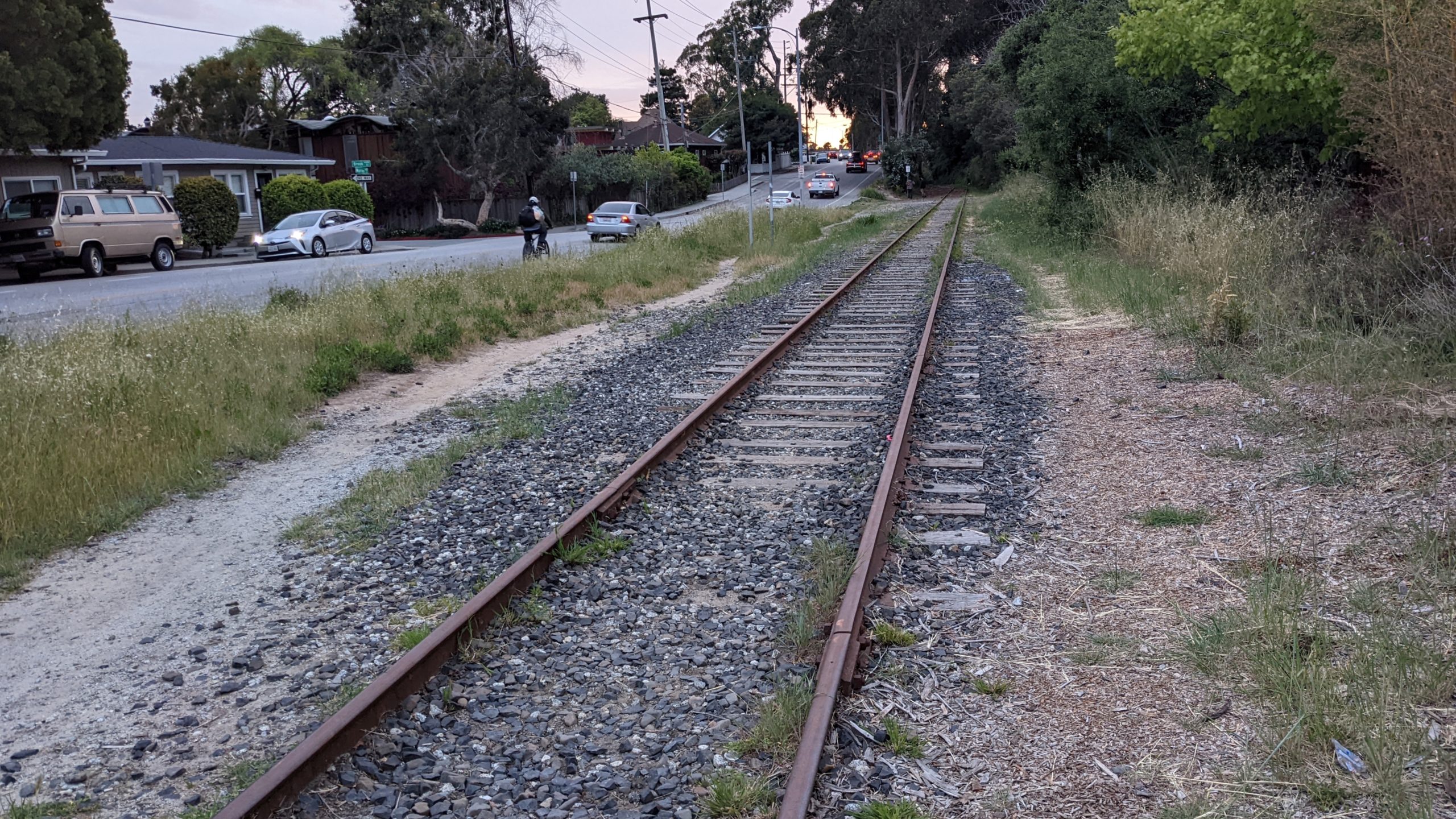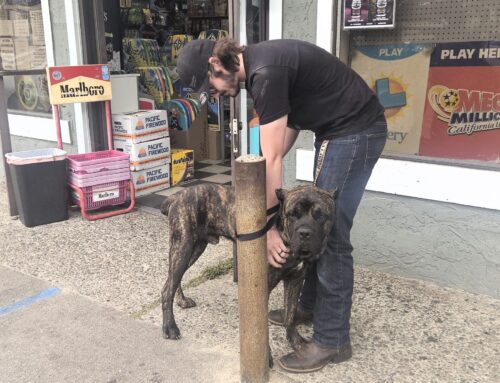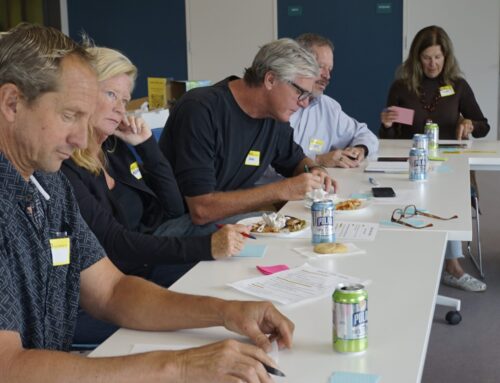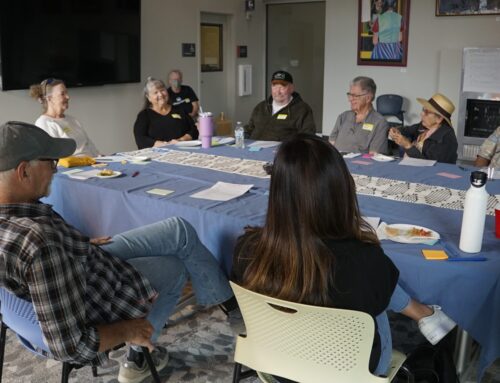
Segment 9 of the Santa Cruz Branch Rail Line runs near Murray Street in Santa Cruz. (Stephen Baxter — Santa Cruz Local file)
SANTA CRUZ >> The Santa Cruz City Council on Monday advanced a plan to build the rail trail alongside the train tracks from Beach Street in Santa Cruz to 17th Avenue in Live Oak.
In a special meeting, the council approved a design permit and an environmental report for the project. The City of Santa Cruz is the lead agency for Segments 8 and 9 from Beach Street to 17th Avenue.
The full rail trail is expected to stretch from Davenport through Watsonville. One section of the trail is complete on Santa Cruz’s Westside.
An environmental report studied “interim” and “ultimate” options for Segment 9 from the east end of the San Lorenzo River trestle bridge to 17th Avenue.
The interim plan:
- Would remove the train tracks to build a path for walkers and cyclists on the rail line. The trail later would be replaced by a reconstructed rail line and another trail alongside the tracks.
- The interim plan would remove 124 trees when the first trail is constructed, then remove 280 more trees when the rail is reconstructed and the permanent trail is constructed, said Santa Cruz Senior Planner Timothy Maier.
The ultimate plan:
- Would keep the railroad tracks and build a path next to it. In December 2022, the California Transportation Commission approved $36 million in grants to complete the section with this ultimate plan.
- The ultimate would remove 381 trees along Segments 8 and 9. Of those trees, 117 trees are within city limits and 107 are designated as heritage trees, according to the environmental report. Heritage trees have diameters more than 14 inches or are otherwise considered ecologically or culturally important. Of the heritage trees, 47 are native trees, according to the report.
In both plans, “For every tree removed, at least two trees are expected to be planted,” said Maier. The trees may be planted at a different site in the county, he said.
The council approved permits for the “ultimate” plan.
Before construction can start, the city and the county will need a coastal development permit from the California Coastal Commission. The city will coordinate with the county to submit a single coastal permit, according to a staff report.
If the commission approves the project, the initial design could be completed by the end of 2023, the report stated.
In a presentation Monday, city staff and consultants recommended the “ultimate” option. In the “ultimate” option, “there would be one construction period instead of three, which would reduce construction-related impacts,” said Kate Elliott, a consultant with Harris and Associates who helped prepare the environmental report.
In the first construction period, the city and county would remove the rails and construct a trail. In the second phase, that trail would be removed and the rail reconstructed. In the third phase, a new trail alongside the rail would be built.
Council vote
The council voted 6–0 to:
- Accept the environmental report.
- Agree with the report’s findings that the benefits of the project outweigh the environmental impacts.
- Approve the design permit, slope modification permit, slope variance and watercourse variance for the project.
Mayor Fred Keeley, Vice Mayor Renee Golder and Councilmembers Sandy Brown, Scott Newsome, Martine Watkins and Sonja Brunner voted in favor. Councilmember Shebreh Kalantari-Johnson was absent.
The permits mark a step towards a future commuter rail system in Santa Cruz, said Brown. “I do think that it’s possible for us to move forward, and I want to see it happen now,” she said.
The city’s planning commission also approved the permit and report on March 2. Monday’s special meeting was prompted by Santa Cruz City Councilmember Sonja Brunner who appealed that decision.
“I think the interim trail is very short sighted and it really does not support the long-range goals that we have,” said Brunner.
Public comment
During public comment, many residents expressed concern about the loss of trees with the “ultimate” plan. Some trees protect monarch butterfly habitat from coastal winds, Elliott said.
Multiple city residents urged the council to approve the “interim” option.
“The near total devastation of eucalyptus row required by the ultimate trail design is unfathomable” said a resident, referring to a strip of trees along Murray Street. “Its absence will invite in pollution, noise, wind and visual clutter from Murray Street and the Beach Boardwalk into my neighborhood.”
City resident Michael Brownlee recommended building the “interim” trail” for 10 years or more until decisions are made about what to do with public transportation on the rail corridor. “I think it makes a lot of sense to allow a generation or two to enjoy the beauty of what exists now.”
Supporters of the “ultimate” plan urged the council to preserve the train tracks for a possible future commuter rail system that could reduce greenhouse gas emissions.
“If we keep going the way we’re going, and we continue driving the way we’re driving, we won’t have our redwood forests with us here in 100 years,” said Faina Segal, board member of rail transit advocacy organization Friends of the Rail and Trail.
Other supporters of the “ultimate” plan cited the failure of Measure D. Measure D was a Santa Cruz County ballot initiative in June that would have changed the county’s General Plan to promote a trail with two lanes of bike traffic on top of where the rails now stand. The measure received about 27% of the vote in the June 7 election.
“If you were to approve only the interim trail, it would be a betrayal of the voters,” said UC Santa Cruz student Isaiah Berke. “This project needs to go forward immediately.”
Read More:
- Passenger rail planning advances in Santa Cruz County (August 5, 2022)
- Rail-trail construction to restart in Santa Cruz (July 8, 2022)
- Measure D routed in official election results in Santa Cruz County (June 7, 2022)
- Rail trail options outlined in Live Oak, Capitola, Seacliff (April 29, 2022)
- Rail-trail ballot measure outlined by Santa Cruz County staff (March 4, 2022)
- Rail trail plans detailed from Santa Cruz to Aptos (February 18, 2022)
- Santa Cruz County rail funding search continues (July 16, 2021)
- Train project slows with lack of planning money (May 7, 2021)
- Santa Cruz County train vote: Factors to consider (May 4, 2021)
- Santa Cruz County transportation leaders deadlock on passenger rail plan (April 2, 2021)
- Train options push ahead for Santa Cruz County rail corridor (Feb. 4, 2021)
Questions or comments? Email [email protected]. Santa Cruz Local is supported by members, major donors, sponsors and grants for the general support of our newsroom. Our news judgments are made independently and not on the basis of donor support. Learn more about Santa Cruz Local and how we are funded.
Jesse Kathan is a staff reporter for Santa Cruz Local through the California Local News Fellowship. They hold a master's degree in science communications from UC Santa Cruz.





